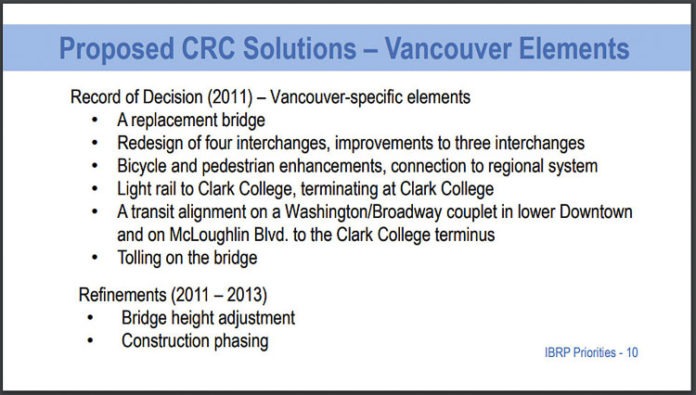
Editor’s Note: This article was produced and first published by Clark County Today, www.clarkcountytoday.com. It is published here with full attribution to and permission of ClarkCountyToday.com and Editor Ken Vance.
The afternoon of June 21, the Vancouver City Council held a workshop to review the Interstate Bridge Replacement Program (IBRP) and the city’s position on key issues. The roughly 45-minute briefing and question and answer session brought the council members up to date on numerous changes since the 2011 Columbia River Crossing (CRC) Record of Decision on the project.
Staff member Katherine Kelly shared that the program stems from studies that began in the 1990s with a review of possible enhancements for Interstate 5. Key issues that prompted previous studies were based primarily around congestion and safety needs.
The Vancouver-supported elements of the CRC were a replacement bridge, the redesign of four interchanges, improvements to three interchanges, light rail that terminated at Clark College, a transit alignment on Washington/Broadway streets in the lower downtown and on McLoughlin Boulevard to the college. They also supported tolling on the bridge and new bike access and pedestrian enhancements to the bridge.
After the program stopped in 2014, the council reengaged via an Aug. 6, 2018, resolution. It supported a replacement bridge, high-capacity transit with a dedicated guideway with a mode to be defined and multimodal enhancements.
Councilor Bart Hansen asked: “we’re still talking about a 10-lane bridge, right?”
“We are still talking about a bridge that has 10 lanes,” responded Rebecca Kennedy. “The way it was designed previously, and what will be reevaluated, is the configuration that was three through lanes in each direction and two auxiliary lanes in each direction. But that is the baseline.”
Hansen responded. “We need to have that discussion, because it’s a pretty big point to be talking about as far as reducing congestion in something that was worked out with Portland.”
That prompted Councilor Ty Stober to respond.
“As I read through this presentation, it screamed, ‘our priority is the movement of cars and not the movement of people,’” he said. “I would like to see elevated up, transportation and personal mobility, so that they feel on par with traffic.” Stober also wants to ensure transit access for downtown and the Renaissance trail.
Councilor Sarah Fox weighed in. “On the heels of the comments of how many lanes this bridge could have, do we have a group that’s really looking at managing congestion as part of this project, because lanes don’t really fix congestion.”
“All studies show you can add 10 more lanes, and people will just get in their cars and fill up all those lanes,” she said. “It just doesn’t take much time; so there has to be some other tools to help manage, and keep those lanes flowing.”
Staff responded saying transportation demand management systems were part of the planning and discussion.
It was not mentioned that it has been 40 years since a new transportation corridor was built or that new vehicle capacity has been added to the two main transportation corridors currently in place.
Stober mentioned that even if Bus Rapid Transit (BRT) were the chosen transit component, he wants to ensure the bridge is constructed to handle light rail.
Process moving forward
The program is tied to the National Environmental Policy Act (NEPA). The first step through NEPA is to define the problems the program will solve. These are documented as a program’s Purpose and Need statement.
The CRC program identified six problems — congestion, seismic resiliency, safety, limited public transportation, freight mobility, and inadequate bike and pedestrian connections. Those problems have been affirmed as still being relevant and those foundational problems that still need to be addressed by the IBRP. Climate and equity elements have been added to the Purpose and Need statement.
Changes were made to the original Record of Decision (ROD). Those changes were adjusting the bridge height from 95 feet to 116 feet, to allow for adequate maritime navigation.
That prompted Stober to ask about the three up-river businesses that were negatively impacted by the CRC’s low bridge height. They were offered millions in compensation. Stober wondered if their circumstances had changed. He assumed the prior compensation agreement was null and void.
Staff highlighted numerous changes that have occurred in the Vancouver side of the “bridge influence area.” These included a New Seasons Market and the Hurley Building being constructed in the planned light rail and park and ride alignment.
New development along the Vancouver Waterfront and Terminal One has occurred but it has been planned so as not to impede on the CRC’s footprint, according to staff.
With regards to transit, The Vine BRT system built the downtown transit corridor, the coming Mill Plain BRT system, and C-TRAN running “bus on shoulder” on certain highways.
During council discussion, many emphasized the importance of pedestrian connections in the downtown area. Furthermore, they mentioned a “community connector,” a lid over I-5.
Staff reminded the council that the previous constraints for the required height of the bridge for river navigation, as well as PDX flight path and the constrained environment and footprint still exist.
City Manager Eric Holmes summed up the meeting.
“High level themes seem to center around the importance of harnessing whatever investment that is made to enhance the sense of place in downtown, the connectivity within downtown and two adjacent areas,” he said. “The bridge itself (should be) focused on mobility as opposed to traffic management, recognizing traffic management is a component of that, but it’s about moving goods and people, not necessarily cars and trucks.”
Holmes will use that as a framework for drafting a resolution that would come back to the council for further discussion.
The council will have two more meetings and discussions regarding the IBRP before likely passing an updated resolution providing direction and support for the project in July.



